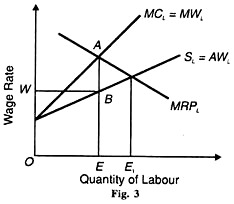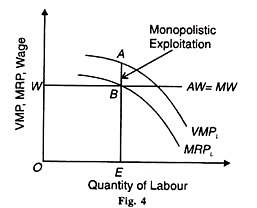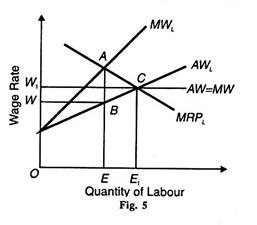In this article we will discuss about Monopsony Exploitation of Labour. After reading this article you will learn about: 1. Meaning of Monopsony Exploitation 2. Situation of Monopsony Exploitation 3. Measures.
Meaning of Monopsony Exploitation:
Monopsony in labour market is a situation in which there is only one firm to buy the services of a particular type of labour. Hence it is regarded as a “buyer’s monopoly”. The term monopsony is derived from the Greek words: mono which means ‘one and posinia which means ‘a buying’.
Monopolistic situations occur when the labour market is imperfect. There is immobility of labour-both occupational and geographical. This is because labour in a particular area is of a special type. It is trained for a particular type of work and its services cannot be utilised by any other firm except the one for which it is specialised. There may be certain other forces preventing labour to migrate to other areas.
They may be ignorance, inertia, social and family considerations, facilities provided by the employer in the form of housing for workers, free education for their children and job priorities to the latter. In the monopsony market, the supply curve of labour facing the firm slopes upward to the right. Monopsony in labour market is found in many mining towns and plantations where the company is the sole employer of labour in that area.
Situation of Monopsony Exploitation:
Economists have explained exploitation of labour fewer than two situations:
ADVERTISEMENTS:
(1) Monopsony in labour market and perfect competition in product market.
(2) Perfect competition in labour market and monopoly (or imperfect competition) in product market.
The first view is held by Prof. Chamberlin and the second by Joan Robinson. We explain them as under.
(1) Monopsony in Labour Market and Perfect Competition in Product market:
ADVERTISEMENTS:
According to Chamberlin, labour is exploited when it is paid less than its marginal revenue product (MRP). It happens when there is monopsony in labour market and perfect competition in product market. The supply curve of labour (SL) shows the wage rate. It is also the average cost (wage) of labour (AWL) at which the workers are employed. When there is monopsony in labour market, the supply curve of labour is upward sloping.
The rising supply curve of labour means, that the monopolist must offer a higher wage to attract more workers. When the average cost (wage) curve of labour is rising, the marginal cost (wage) curve (MWL) must be above it and rising faster.
In Figure 3, SL (= AWL ) is the supply curve of labour and MCL (=MWL) is its corresponding marginal cost curve of labour. MRPL is the demand curve for labour on the part of the monopolist, which is the marginal revenue product of labour.
To maximise his profits, the monopolist would employ labour up to point A at which MRPL = MC. At this point, he employs OE workers at the wage rate OW (= EB). But this wage rate (EB) is less than marginal revenue product (EA) of workers by BA. This shows that by employing OE workers the monopolist is able to earn BA profit per worker. Thus BA is monopolist exploitation of labour.
(2) Perfect Competition in Labour Market and Monopoly or Imperfect Competition in Product Market:
ADVERTISEMENTS:
According to Joan Robinson, labour is exploited when it is paid less than the value of its marginal product (VMP). In a perfectly competitive labour market, the wage rate is given for the firm (as fixed by industry) which means that average wage is equal to marginal wage – the curve AW = MW curve.
This is the supply curve of labour which is horizontal to the X-axis. Since there is monopoly or imperfect competition in product market, the marginal revenue (MR) is less than the price (AR) of the product.
Therefore the marginal revenue product of labour (MRPL) will be less than the value of marginal product of labour (VMPL). Symbolically
MR < Price (under monopoly both AR (P) and MR slope downward).
MRPL < VMP, The monopolistic firm will be in equilibrium where the marginal revenue product of labour (MRPL) equals the marginal wage (MW). This is shown in Figure 4 by point В where the firm employs OE units of labour at OW (=EB) wage rate.
But the value of marginal product of OE labour employed is EA. As labour is being paid EB (=OW) wage which is less than its value of marginal product EA, the difference between EA – EB = BA. This is monopolistic exploitation of labour by the firm.
Measures to Reduce or Remove Exploitation of Labour:
Labour exploitation can be reduced or eliminated only in the case of monopsonistic exploitation in the following ways:
ADVERTISEMENTS:
1. By increasing the mobility of labour. In the case of a certain type of labour, this can be done by providing job information at other places through government and private agencies. In developed countries, workers are trained for other occupations by trade unions which also subsidies moving expenses of workers.
2. Another method is the fixation of a minimum wage for workers in jobs where they are monopolistically exploited.
3. If the unorganised workers form a union, the latter can eliminate monopsonistic exploitation. By collective bargaining, the union can fix a higher wage rate for all the workers, and the monopsonist can hire as many workers at that level as he wishes.
The supply curve facing him would be horizontal as under perfect competition. The marginal wage of labour will coincide the average wage (MW = AW) and the equilibrium will be where the MRPL curve equals the union wage. This is explained in Figure 5.
ADVERTISEMENTS:
Suppose in Figure 5, the union and the monopolist agree to a higher wage OW1 so that the supply curve of labour becomes horizontal line, shown as W-AW = MW. The monopolist will now move to the point С where the MRPL curve intersects the line W1 – AW = MW and OE1 employment level is established.
The union has been able to raise not only the wage rate from OW to OW1 but also the level of employment from OE to OE1. There is no monopolistic exploitation because each worker receives the wage rate OW1 equal to his MRPL and more workers are employed.
4. But monopolistic exploitations of labour cannot be removed by trade union action as there is monopoly or imperfect competition in product market. If, however, the government adopts measures to remove imperfections or monopoly conditions in the product market through taxation and, or legislative measures, labour exploitation can be reduced to some extent.


